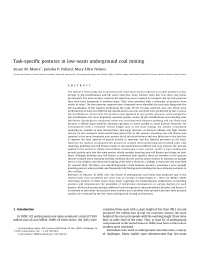Mining Publication: Task-Specific Postures in Low-Seam Underground Coal Mining
Original creation date: March 2012
The objective of this study was to determine low-seam mine worker exposure to various postures as they pertain to job classifications and job tasks. Sixty-four mine workers from four low-seam coal mines participated. The mine workers reported the tasks they were required to complete and the two postures they used most frequently to perform them. They were provided with a schematic of postures from which to select. The two postures reported most frequently were identified for each task along with the job classification of the workers performing the tasks. Of the 18 tasks reported, over two thirds were performed by at least two different job classifications and over one third were performed by four or more job classifications. Across tasks, the postures used appeared to vary greatly. However, when grouped by job classification, the most frequently reported posture across all job classifications was kneeling near full flexion. Operating the continuous miner was associated with frequent squatting and was likely used because it affords great mobility, allowing operators to move quickly to avoid hazards. However, for environments with a restricted vertical height such as low-seam mining, the authors recommend squatting be avoided as data demonstrates that large amounts of femoral rollback and high muscle activity for the extensors when performing lateral lifts in this posture. Kneeling near full flexion was reported as the most frequently used posture by all job classifications and was likely due to the fact that it requires the least amount of muscle activity to maintain and has reduced pressures at the knee. However, the authors recommend this posture be avoided when performing lateral lifting tasks. Like squatting, kneeling near full flexion results in increased femoral rollback and may increase the stresses applied to the meniscus. Unlike lateral lifting, maintaining a static posture results in knee loading and muscle activity such that the mine worker should consider kneeling near full flexion and sitting on their heels. Although kneeling near full flexion is associated with injuries, there are benefits to this posture that are realized when statically kneeling (minimal muscle activity, allows worker to maintain an upright torso in low heights, and decreased loading at the knee). However, cartilage is avascular and nourished by synovial fluid. Therefore, one should frequently rotate between postures, assuming a more upright kneeling posture when possible and frequently fully flexing and extending the knee allowing nutrients to the cartilage.
Authors: SM Moore, JP Pollard, M Nelson
Peer Reviewed Journal Article - March 2012
NIOSHTIC2 Number: 20040511
Int J Ind Ergon 2012 Mar; 42(2):241-248
See Also
- An Approach to Identify Jobs for Ergonomic Analysis
- Electromyography of the Thigh Muscles during Lifting Tasks in Kneeling and Squatting Postures
- Ergonomic and Statistical Assessment of Safety in Deep-Cut Mines
- Forces and Moments on the Knee During Kneeling and Squatting
- Job Design: An Effective Strategy for Reducing Back Injuries
- Job Training Analysis: A Process for Quickly Developing a Roadmap for Teaching and Evaluating Job Skills
- Pressures Applied to Anatomical Landmarks of the Knee While in Kneeling Postures
- Thigh-Calf and Heel-Gluteus Contact Forces in High Flexion: Experimental Results
- Toward a Typology of Dynamic and Hazardous Work Environments
- Working in Unusual or Restricted Postures
- Content source: National Institute for Occupational Safety and Health, Mining Program


 ShareCompartir
ShareCompartir
